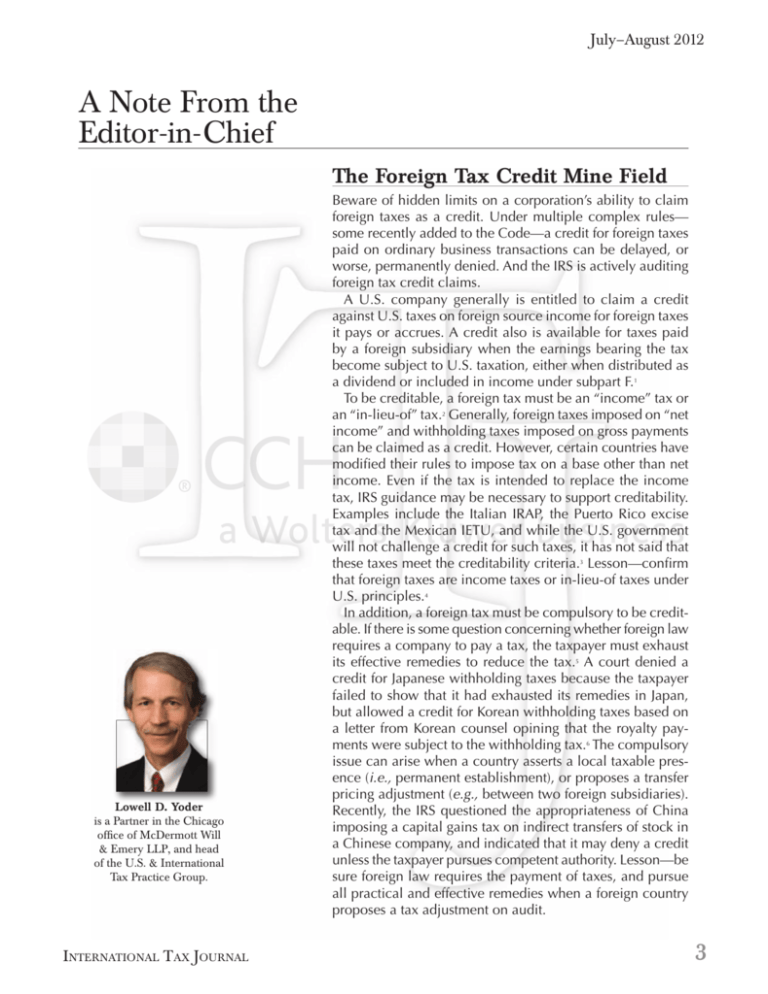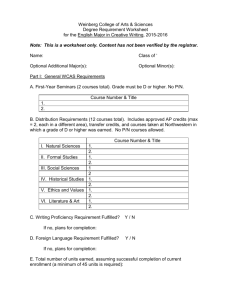
July–August 2012
A Note From the
Editor-in-Chief
The Foreign Tax Credit Mine Field
Lowell D. Yoder
is a Partner in the Chicago
office of McDermott Will
& Emery LLP, and head
of the U.S. & International
Tax Practice Group.
INTERNATIONAL TAX JOURNAL
Beware of hidden limits on a corporation’s ability to claim
foreign taxes as a credit. Under multiple complex rules—
some recently added to the Code—a credit for foreign taxes
paid on ordinary business transactions can be delayed, or
worse, permanently denied. And the IRS is actively auditing
foreign tax credit claims.
A U.S. company generally is entitled to claim a credit
against U.S. taxes on foreign source income for foreign taxes
it pays or accrues. A credit also is available for taxes paid
by a foreign subsidiary when the earnings bearing the tax
become subject to U.S. taxation, either when distributed as
a dividend or included in income under subpart F.1
To be creditable, a foreign tax must be an “income” tax or
an “in-lieu-of” tax.2 Generally, foreign taxes imposed on “net
income” and withholding taxes imposed on gross payments
can be claimed as a credit. However, certain countries have
modified their rules to impose tax on a base other than net
income. Even if the tax is intended to replace the income
tax, IRS guidance may be necessary to support creditability.
Examples include the Italian IRAP, the Puerto Rico excise
tax and the Mexican IETU, and while the U.S. government
will not challenge a credit for such taxes, it has not said that
these taxes meet the creditability criteria.3 Lesson—confirm
that foreign taxes are income taxes or in-lieu-of taxes under
U.S. principles.4
In addition, a foreign tax must be compulsory to be creditable. If there is some question concerning whether foreign law
requires a company to pay a tax, the taxpayer must exhaust
its effective remedies to reduce the tax.5 A court denied a
credit for Japanese withholding taxes because the taxpayer
failed to show that it had exhausted its remedies in Japan,
but allowed a credit for Korean withholding taxes based on
a letter from Korean counsel opining that the royalty payments were subject to the withholding tax.6 The compulsory
issue can arise when a country asserts a local taxable presence (i.e., permanent establishment), or proposes a transfer
pricing adjustment (e.g., between two foreign subsidiaries).
Recently, the IRS questioned the appropriateness of China
imposing a capital gains tax on indirect transfers of stock in
a Chinese company, and indicated that it may deny a credit
unless the taxpayer pursues competent authority. Lesson—be
sure foreign law requires the payment of taxes, and pursue
all practical and effective remedies when a foreign country
proposes a tax adjustment on audit.
3
A Note From the Editor-in-Chief
A person liable for taxes under foreign law generally is entitled to claim a credit. Recent legislation
and regulations, however, can treat foreign taxes
as paid by another taxpayer or suspend the credits
(sometimes indefinitely). For example, foreign taxes
paid by a member of a foreign consolidated group
may be treated as paid by another member of the
group if attributable to such other member’s income.
In addition, while taxes normally are treated as
accruing at the end of an entity’s year, certain midyear transactions can require allocation of the taxes
between two entities (e.g., the sale of interests in a
disregarded entity).7 Furthermore, under so-called
splitter rules, certain taxes paid by a company without the corresponding income are suspended. For
example, partners generally are liable for taxes paid
on income of a foreign partnership. If the partnership is classified as a corporation for U.S. purposes,
such taxes are not creditable to the partners until
the associated earnings of the partnership are distributed, and under regulations all earnings must
be distributed before all of the credits are freed up.8
Lesson—be aware of the special rules that can apply
when taxes are paid by one corporation on income
of another corporation.
Another new rule denies a credit for certain otherwise creditable foreign taxes paid on operating
income. The rule generally applies to transactions that
are treated as acquisitions of stock (or are disregarded)
for foreign tax purposes but that are treated as asset
acquisitions for U.S. tax purposes (e.g., a Code Sec.
338 election is made, or the target is a disregarded
entity or a partnership). Such transactions can result
in additional U.S. deductions for depreciation and
amortization attributable to the stepped up basis of
the foreign target’s assets without affecting the amount
of taxable income or taxes for foreign law purposes.
Under Code Sec. 901(m), future foreign taxes paid by
the target are denied as a credit to the extent paid on
the amount of its foreign income that is unreduced by
the additional U.S. deductions. The denial of credits
applies equally to internal transactions. Lesson—be
aware of the rules that disallow a credit for foreign
taxes paid on foreign income to the extent it exceeds
U.S. income as a result of a transaction.
To be entitled to a credit for foreign taxes associated
with dividends received from a foreign subsidiary, a
U.S. shareholder must own directly 10 percent of the
voting stock of the distributing corporation (the same
rule applies for subpart F inclusions). Unfortunately,
this rule has been applied rigidly to U.S. consolidated
groups.9 For example, assume a consolidated group
owns in the aggregate all of the stock of a foreign subsidiary, but one domestic subsidiary owns eight percent
directly. The deemed paid taxes otherwise accompanying a dividend paid to the eight-percent owner are not
allowed as a credit (and they disappear). Lesson—carefully monitor the 10-percent ownership rules.10
Another trap is the tier limitation. A U.S. shareholder is entitled to claim a deemed paid foreign tax
credit only for taxes paid by controlled foreign corporations (CFCs) that are no more than six tiers below
the U.S. owner. It is not uncommon for ownership
structures to inadvertently end up with more than six
tiers, e.g., with acquisitions or internal reorganizations. Foreign taxes paid by a seventh tier subsidiary
are not creditable. Lesson—monitor the foreign ownership structure to avoid CFCs below six tiers, and
restructure to eliminate too many tiers (e.g., using
disregarded entity elections for intermediate entities).
There are numerous other limitations on the ability
to use foreign tax credits. For example, credits are allowed on a basket-by-basket basis, requiring separately
tracking the different baskets. Moreover, the U.S. interest expense allocation rules can significantly reduce or
eliminate foreign source income and create an overall
foreign loss account, which prevents or limits utilization of foreign tax credits, even when the U.S. taxpayer
derives substantial foreign source income. In addition,
the rules are uncertain and complex concerning the
treatment of foreign taxes in dispute.
With much talk in Washington concerning a territorial tax system, it may be that the future U.S. tax
system will not fundamentally rely on the foreign
tax credit rules to eliminate double taxation of crossborder profits, and that would be good.
ENDNOTES
1
2
3
4
4
Code Secs. 901(a), 902(a).
Reg. §1.901-2(a)(3), (b); Code Sec. 903.
U.S.-Italian Tax Treaty, Art. 23; Notice 201129, IRB 2011-16, 663 (Puerto Rico); Notice
2008-3, IRB 2008-2, 253 (Mexico).
Recently, one circuit court held that the U.K.
Windfall Tax was creditable (Entergy Corp.,
CA-5, 2012-1 USTC ¶50,386), but another
5
6
7
circuit court held that the U.K. tax was not
creditable because it was not imposed on
net income (PPL Corp., CA-3, 2012-1 USTC
¶50,115, 665 F3d 60).
Reg. §1.901-2(a)(2)(i), (e)(5)(i).
Procter & Gamble Company, DC-Ohio, 106
AFTR2d 2010-5311 (2010).
Reg. §1.901-2(f).
©2012
CCH. All Rights Reserved
8
9
10
Code Sec. 909 and temporary regulations
issued pursuant thereto.
First Chicago NBD Corp., CA-7, 98-1 USTC
¶50,169, 135 F3d 457.
This issue can arise with cross-chain transactions under Code Secs. 304 or 368(a)(1)(D)
that give rise to dividends.









